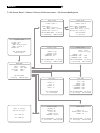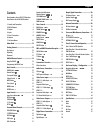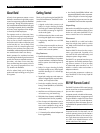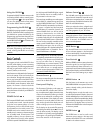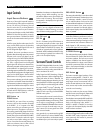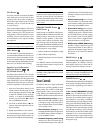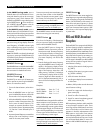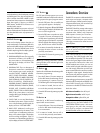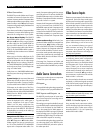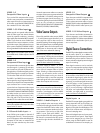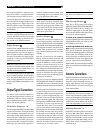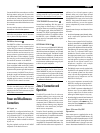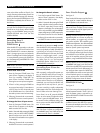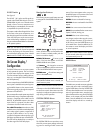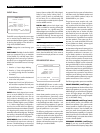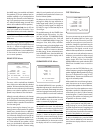
18
RSX-972 Surround Sound Receiver
Video Connections
The RSX-972 provides S-Video and Compo-
nent Video connections for those who wish to
use them. However, standard Composite video
cables provide excellent picture quality in most
systems and their use for all input and output
connections will greatly simplify installation and
configuration of the unit.
If you chose to use S-Video or Component Video
connections, be aware of the following impli-
cations for the configuration of your system:
On Screen Menu Display: The RSX-972
ON-SCREEN MENU system is available for
all inputs at all times when using a Compos-
ite video cable from the TV MONITOR out-
puts to an NTSC standard. TV set. When us-
ing a Composite video cable with a PAL stan-
dard TV, the ON-SCREEN MENU system is
available only when a video source is selected
and playing.
When using an S-Video cable from the TV
MONITOR outputs, the ON-SCREEN MENU
will be superimposed over the video image
only while the source is playing. Therefore,
no ON-SCREEN MENU is available from an
audio only source (Tuner, CD, and Tape) when
using an S-Video cable.
Finally, there is no ON-SCREEN MENU avail-
able at any time when using Component video
cables.
System Set-Up: We recommend that initial
system setup should be done while using a
Composite video cable. Connect a Compos-
ite video cable from the RSX-972 TV MONI-
TOR outputs to the video input of the TV or
projector. No other video connections should
be made at this time. Select OSD (ON-SCREEN
MENU) from the RR-969 remote control to
complete system set-up.
NOTE:
On a PAL standard monitor, the OSD
cannot be displayed until a video signal is
present, irrespective of the type of video
cables in use. For setup, connect the Com-
posite video output from your DVD player and
select its input on the RSX-972. The OSD will
be displayed as an overlay to the video sig-
nal from the DVD player.
Composite and S-Video: With certain ex-
ceptions, a system should be connected with
either all Composite or all S-Video cables.
S-Video signals from sources cannot be sent
to a TV set from the RSX-972 TV MONITOR
outputs with a Composite video cable. Con-
versely, Composite video signals from sources
cannot be sent to a TV set from the RSX-972
TV MONITOR outputs with an S-Video cable.
Therefore, Composite and S-Video connections
cannot be “mixed” in a system.
However, both Composite and S-Video cables
may be connected from the RSX-972 TV
MONITOR outputs to both Composite and S-
Video inputs on a TV or projector. This dual
connection from the RSX-972 will provide lim-
ited S-Video capability in a system that is pre-
dominantly connected with Composite video
cables.
A Note on Recording: When both Com-
posite and S-Video cables are connected from
the same source, only S-Video will be avail-
able at the RSX-972 S-Video TV MONITOR
outputs. However, the Composite video REC
Out will still be available. This dual connec-
tion can be used to provide video taping in a
system that is predominantly connected with
S-Video cables, but also includes a VCR with
Composite video.
Converting from Composite to S-Video and
from S-Video to Composite is possible with the
use of special cables available from your Rotel
dealer.
Audio Source Connections
Connect your audio-only source components
to these RCA inputs and outputs:
CD Inputs
Connect the left and right analog outputs from
your CD player to the input jacks labeled CD.
TAPE Inputs and Outputs
The RSX-972 provides a pair of inputs and a
pair of record outputs for connecting an ana-
log audio tape deck.
The analog source signal available for record-
ing at the TAPE outputs is selected with the REC
button on the front-panel (or the ZONE but-
ton on the remote) and its label appears in
the display. If the TAPE input signal is selected
as the recording source, its signal will not be
available at the TAPE output, but will be avail-
able at the VIDEO outputs for recording.
Connect the left and right analog
outputs
from
an audio tape deck to the TAPE IN jacks.
Connect the TAPE OUT jacks to the
inputs
on
the audio tape deck.
Video Source Inputs
There are input connections for five video source
components. Each of the five provides a pair
of RCA inputs for analog audio signals. Each
of the five also provides a choice of an RCA
composite video input or S-Video input for the
video signal from the source component. In
addition, two of the video source inputs (Video
1 and Video 2) also feature Component Video
input connections as an alternative to the com-
posite video or S-Video connections.
NOTE
: There is no need to use more than one
type of video connection from a source com-
ponent. While doing so will no harm to the
unit, we recommend selecting one type of
video connection and using it for all video
connections. As a general rule, using RCA
composite video connections will simply sys-
tem setup and operation.
There are also video record outputs (described
in a following section) which correspond to
three of the video source inputs – Video 1, 2,
and 3). For this reason, you should plan ahead
and designate each source component as
Video 1, Video 2, etc. All connections (both
input and output) from a source component
must be made consistently to the same set of
connections. For example, all input and out-
put connections to a particular VCR could be
made to Video 1 connectors.
Also, be sure that the channels are connected
consistently, i.e. left channel signals connected
to left channel inputs/outputs and right chan-
nel signals connected to right channel inputs/
outputs.
NOTE
: These video source inputs can also be
used for additional audio-only sources, omit-
ting the video signal connections.
VIDEO 1–5 Audio Inputs
Using standard audio interconnect cables,
connect the left and right channel analog au-
dio
outputs
of VCRs or other source compo-
nents to the VIDEO 1, 2, 3, 4, or 5
inputs
using
standard RCA audio cables.



